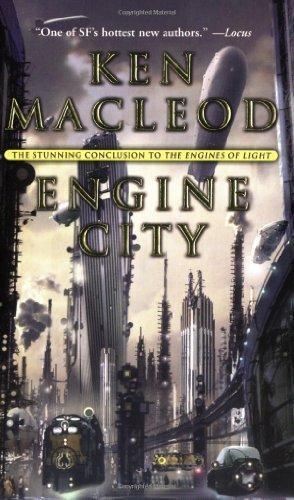TrendyWebAltar commented on Engine City by Ken MacLeod (Engines of Light, #3)
One prologue and two chapters in:
The prologue is more a recap of the backstory revealed in the previous novel Dark Light. I don't consider it redundant though and pretty much welcome it as a straightforward telling via a third-person omniscient (?) POV. It also adds something of a theory of evolution, contrasting how the more volatile processes on Earth (when compared to "simpler" asteroids) led to multicellular evolution, while "extremophile nanobacteria" evolved in the asteroids. The latter become gods, exponentially more intelligent (though that may also be the result of longer time spans). Good stuff to think about.
Like the previous two novels, Engine City opens with a starship arriving on a planet: this time it's the older civilisations of Nova Terra. I initially thought that we were moving from planet to planet (Mingulay to Croatan to Nova Terra) on the basis of technological advancement, but no, the point with lightspeed travel in these books is how they cause jumps in social development (technology of course but also fashion, discussions of which have appeared previously). So I think we're going towards older civilizations: the humans on Kyohvic, Mingulay were from the Bright Star (at least those who were ruling) or refugees from Croatan. Rawliston, Croatan seems to have been industrialised by pre-space age folks who first arrived as early hominids or as pre-20th century cultures (some reference to early Christians). New Babylonia, Nova Terra have been around for ten thousand years. There's an SPQR that appears so there is that Classical Roman link. It's described here as somewhat like Coruscant, and the world cultural geography is two main continents, one predominantly occupied by saurs and the other by humans, with some "transients" from either race. As for characters and plot, this is mostly Volkov and the De Tenebres. The key points here are how 200 years have passed since the De Tenebres left so they're now facing a family comprising the descendants of those who saw them off and also a really interesting epistemological debate with Volkov clashing with the intelligentsia of New Babylonia on how to "extract" the secret of longevity (V proposes the scientific method, but New Babylonia academics default to something more speculative, based on rationalism, logic, archival research, rather than empirics.)
Chapter 2 brings us Elizabeth and Gregor (WHERE IS SALASSO?!) on the southern hemisphere of Mingulay. This is great because it gives us a new view of Mingulay, unpopulated and remote. The two of them make a discovery that serves as evidence of another alien life form we've only read about rather than actually encountered...and there's a second encounter too with another migrant species from Earth: selkies! Great thing about this chapter is the way in which two species without a common language try to communicate with each other--successfully, too. I think I like how these novels have quite the optimistic feel to them, at least in this regard.

